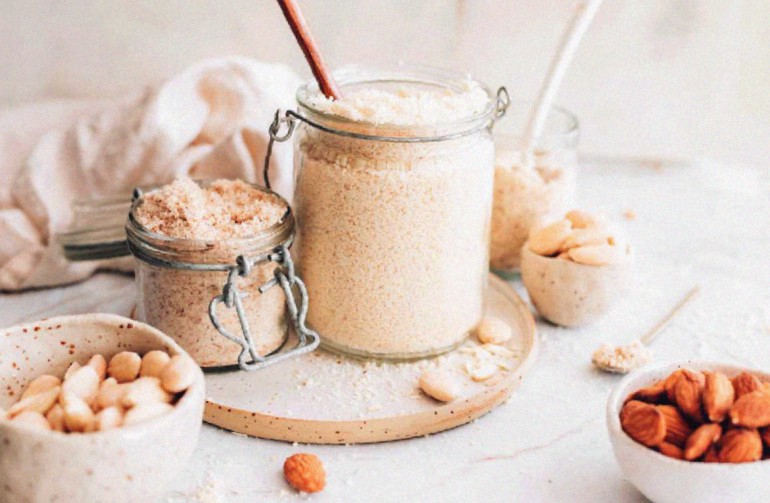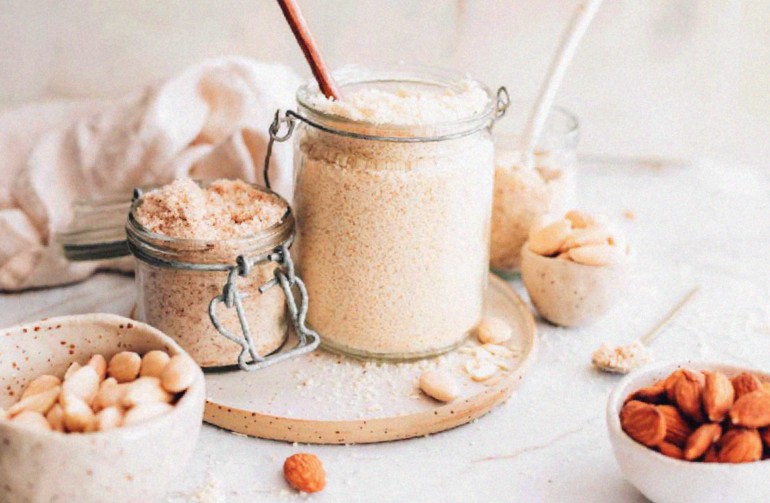
Are you a fan of almond flour but not the hefty price tag that comes with it? Or perhaps you’re eager to embark on a culinary adventure and create almond flour from scratch?
Exciting news: We’re about to unveil the secrets of making your own almond flour without breaking the bank!
Producing your almond flour at home not only lets you save some bucks but also ensures a steady supply at your fingertips. If you’re following a gluten-free lifestyle, almond flour is your trusty companion for all your baking aspirations.
Here, we’ll present you with invaluable insights and ingenious techniques for producing your personal almond flour haven.
Unveiling the Essence of Almond Flour
Almond flour emerges as a delectable and grain-free substitute for traditional wheat flour. This ingredient boasts a delightful nuttiness that enhances your baked wonders.
It all comes down to one star ingredient: finely ground almonds. These little powerhouses are transformed into a powdery consistency through the art of blending or food processing.
The Almond Flour vs Almond Meal Dilemma
Though often used interchangeably, almond flour and almond meal hold distinctive characteristics.
Almond Flour is meticulously crafted from blanched almonds, devoid of their skin. This results in a delicate, pale, and powdery texture that’s perfect for various recipes.
Almond Meal, on the other hand, utilizes raw almonds with their skins intact, leading to a slightly coarser texture adorned with charming brown flecks.
Your choice between almond flour and almond meal depends on your culinary endeavors. For recipes craving a lighter texture, almond flour triumphs as the ideal contender.

Crafting Your Almond Flour Oasis
Selecting the Prime Almonds
The journey to almond flour excellence begins with choosing the perfect almonds!
-
Raw, Unsalted, Unpeeled Almonds: These unprocessed almonds come stripped of their husks, ideal for crafting almond meal.
-
Blanched Almonds: The raw, unsalted almonds without skins are the golden ticket for almond flour. While some stores stock blanched almonds, they can be pricier. Fear not, as you can easily blanch your own (and we’ll guide you shortly!).
-
Slivered Almonds: These are blanched almonds gracefully sliced into slender pieces—perfect for almond flour creation. Often more budget-friendly and accessible in stores!
The Art of Almond Blanching
Blanching almonds isn’t just a culinary chore; it’s a delightful process, albeit a tad time-consuming. For those unable to secure slivered almonds, this pathway leads to almond flour success!
Behold the steps:
-
Measure Almonds: Determine the required almond quantity.
-
Brief Hot Water Bath: Immerse almonds in hot/slightly boiling water for precisely 60 seconds (overdoing it results in soft, hard-to-peel almonds).
-
Cool and Drain: Drain almonds, rinsing them under ice-cold water.
-
Dry Gently: Pat the almonds with a towel until mostly dry.
-
Skin Removal: Pinch the almonds, and watch the skins effortlessly pop off. Aim the almond towards a bowl to avoid unexpected launches across the room!
Nurturing Your Almond Flour Treasure
Remember, your freshly created almond flour deserves a cozy abode:
Storage: Shelter your almond flour in an airtight container. It thrives in the fridge for up to 3 months or the freezer for 6 months. If opting for the pantry, it stays fresh for 2-3 weeks.
Guarding Against Rancidity: Given almonds’ oil-rich, fatty nature, shield your almond flour from heat, humidity, and sunlight to thwart rancidity.
Embracing Almond Flour’s Versatility
Now, your bespoke almond flour eagerly awaits its culinary debut! This fiber-rich marvel imparts a delightful texture to an array of baked wonders, including cookies, pizza crusts, pancakes, and cakes.
Dive into these tantalizing recipes and savor the magic of almond flour.
Unlocking the Almond Flour FAQs


Beyond Almonds: Exploring Nut Flour Diversity
The intrigue doesn’t end with almonds—many nut varieties await transformation into splendid flours. Each imparts a unique flavor profile to elevate your culinary creations.
Delight in these alternative nut flours:
- Hazelnut
- Pecan
- Cashew
- Walnut
- Chestnut
- Macadamia
These nut flours don’t merely thrive in baking; they also excel in coating and frying foods or adding a tantalizing crunch as a savory topping.
Elevating Your Culinary Expertise
- Mastering Oat Flour Creation
- Navigating Oil-Free Cooking
- Embarking on a Vegan Culinary Journey
- Crafting Irresistible Bliss Balls
- Unleashing the Magic of Spiralized Veggies
Your culinary exploration has just begun! Venture into these guides to unravel more kitchen wonders.



